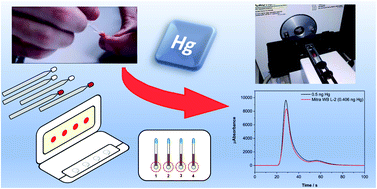A simple and direct atomic absorption spectrometry method for the direct determination of Hg in dried blood spots and dried urine spots prepared using various microsampling devices†
Abstract
The use of dried matrix spots, such as dried blood spots (DBSs) and dried urine spots (DUSs), is becoming more popular in clinical analyses, beyond their traditional use for screening newborns. Currently, there are new types of microsampling devices that have been designed to collect a low and known volume of biological fluids, regardless of the hematocrit level, thus making it feasible to develop fully quantitative methods for their analysis. In this study, three of the most promising microsampling devices (Capitainer B, Hemaxis DB 10 and Mitra) were evaluated aiming at the direct determination of Hg using a dedicated “analyzer” based on atomic absorption spectrometry. Whole blood and urine reference materials were used to evaluate the methods developed. This Hg analyzer possesses a gold trap to enhance the sensitivity and minimize matrix effects, enabling direct analysis of the solid DBS and DUS samples using calibration with Hg aqueous solutions, with an instrumental limit of detection (LOD) and quantification (LOQ) of 3.4 and 11 pg, respectively. LODs when using the three microsampling devices were similar, ranging between 2.5 and 3.2 μg L−1. It is also demonstrated that the simultaneous analysis of four Mitra derived DBSs in a quartz boat results in a decrease of the LOD to 0.32 μg L−1.



 Please wait while we load your content...
Please wait while we load your content...